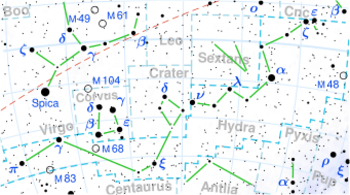Astronomy:2MASS J11145133−2618235
Coordinates: ![]() 11h 14m 51.337s, −26° 18′ 23.56″
11h 14m 51.337s, −26° 18′ 23.56″
| Observation data Equinox J2000.0]] (ICRS) | |
|---|---|
| Constellation | Hydra |
| Right ascension | 11h 14m 51.337s[1] |
| Declination | −26° 18′ 23.56″[1] |
| Characteristics | |
| Spectral type | T7.5[2][3][4][5][6] |
| Apparent magnitude (i (GMOS filter system)) | 23.21 ± 0.09[5] |
| Apparent magnitude (z (GMOS filter system)) | 19.59 ± 0.04[5] |
| Apparent magnitude (J (2MASS filter system)) | >15.86 ± 0.08[2][3] |
| Apparent magnitude (J (MKO filter system)) | 15.52 ± 0.05[6] |
| Apparent magnitude (H (2MASS filter system)) | >15.73 ± 0.12[3] |
| Apparent magnitude (H (MKO filter system)) | 15.82 ± 0.05[6] |
| Apparent magnitude (KS (2MASS filter system)) | >16.1[3] |
| Apparent magnitude (KS (MKO filter system)) | 16.54 ± 0.05[6] |
| Astrometry | |
| Proper motion (μ) | RA: -3018.8 ± 1.1[7] mas/yr Dec.: -384.1 ± 1.4[7] mas/yr |
| Parallax (π) | 179.2 ± 1.4[7] mas |
| Distance | 18.2 ± 0.1 ly (5.58 ± 0.04 pc) |
| Details | |
| Mass | 0.029–0.048[4] M☉ |
| Mass | 30–50[4] MJup |
| Surface gravity (log g) | 5.0–5.3[4] cgs |
| Temperature | 725–775[4] K |
| Metallicity | -0.3 ± 0.1 [m/H][4] |
| Age | 3–8[4] Gyr |
| Other designations | |
| Database references | |
| SIMBAD | data |
Location of 2M1114−26 in the constellation Hydra | |
2MASS J11145133−2618235 (designation abbreviated to 2MASS 1114−2618), [3] or 2M1114−26,[2] or 2M1114−2618,[2] or 2MASS 1114−26,[4] or 2MASS J1114−2618[6]) is a nearby brown dwarf of spectral class T7.5, located in constellation Hydra[lower-alpha 1] at approximately 18 light-years from Earth.[7]
Discovery
2MASS 1114−2618 was discovered in 2005 by C. G. Tinney et al. from the 2MASS Wide-Field T Dwarf Search (WFTS), based on observations obtained at the Anglo-Australian Telescope, Siding Spring, Australia. In 2005 Tinney et al. published a paper in The Astronomical Journal, where they presented discovery of five new brown dwarfs of spectral type T, among which also was 2MASS 1114−2618.[2]
Distance
Trigonometric parallax of 2MASS 1114−2618, measured in 2012 by Dupuy & Liu under The Hawaii Infrared Parallax Program, is 0.1792 ± 0.0014 arcsec, corresponding to a distance 5.58 ± 0.04 pc, or 18.20 ± 0.14 ly.[7]
The photometric distance estimate of 2MASS 1114−2618, published in its discovery paper in 2005, is 7 pc (22.8 ly).[2] Spectrophotometric distance estimate by Kirkpatrick et al. (2012), is 6.6 pc (21.5 ly).[8]
Proper motion
2MASS 1114−2618 has quite a large proper motion of 3043.2 mas/yr with position angle 262.75 degrees,[7] indicating motion in south-west direction on the sky. At distance 18.20 ly (assuming parallax 179.2 ± 1.4 mas),[7] corresponding tangential velocity is 80.56 km/s.[7]
See also
The other four discoveries of brown dwarfs, presented in Tinney et al. (2005):[2]
- 2MASS 0050−3322 (T7.5)
- 2MASS 0939−2448 (T8, binary brown dwarf)
- 2MASS 0949−1545 (T1)
- 2MASS 1122−3512 (T2)
Notes
- ↑ The nearest known star/brown dwarf in this constellation.
References
- ↑ Jump up to: 1.0 1.1 1.2 1.3 "2MASS J11145133-2618235 -- Brown Dwarf (M<0.08solMass)". Centre de données astronomiques de Strasbourg. http://simbad.u-strasbg.fr/simbad/sim-basic?Ident=2MASSJ11145133-2618235&submit=SIMBAD+search.
- ↑ Jump up to: 2.0 2.1 2.2 2.3 2.4 2.5 2.6 2.7 2.8 2.9 Tinney, C. G.; Burgasser, Adam J.; Kirkpatrick, J. Davy; McElwain, Michael W. (2005). "The 2MASS Wide-Field T Dwarf Search. IV. Hunting Out T Dwarfs with Methane Imaging". The Astronomical Journal 130 (5): 2326–2346. doi:10.1086/491734. Bibcode: 2005AJ....130.2326T.
- ↑ Jump up to: 3.0 3.1 3.2 3.3 3.4 3.5 Burgasser, Adam J.; Geballe, T. R.; Leggett, S. K.; Kirkpatrick, J. Davy; Golimowski, David A. (2006). "A Unified Near-Infrared Spectral Classification Scheme for T Dwarfs". The Astrophysical Journal 637 (2): 1067–1093. doi:10.1086/498563. Bibcode: 2006ApJ...637.1067B.
- ↑ Jump up to: 4.0 4.1 4.2 4.3 4.4 4.5 4.6 4.7 4.8 Leggett, Sandy K.; Marley, Mark S.; Freedman, Richard; Saumon, Didier; Liu, Michael C.; Geballe, Thomas R.; Golimowski, David A.; Stephens, Denise C. (2007). "Physical and Spectral Characteristics of the T8 and Later Type Dwarfs". The Astrophysical Journal 667 (1): 537–548. doi:10.1086/519948. Bibcode: 2007ApJ...667..537L.
- ↑ Jump up to: 5.0 5.1 5.2 Leggett, Sandy K.; Saumon, Didier; Marley, Mark S.; Lodders, Katharina; Canty, J.; Lucas, Philip W.; Smart, Richard L.; Tinney, Chris G. et al. (2012). "The Properties of the 500 K Dwarf UGPS J072227.51-054031.2 and a Study of the Far-red Flux of Cold Brown Dwarfs". The Astrophysical Journal 748 (2): 74. doi:10.1088/0004-637X/748/2/74. Bibcode: 2012ApJ...748...74L.
- ↑ Jump up to: 6.0 6.1 6.2 6.3 6.4 6.5 Faherty, Jacqueline K.; Burgasser, Adam J.; Walter, Frederick M.; Van der Bliek, Nicole; Shara, Michael M.; Cruz, Kelle L.; West, Andrew A.; Vrba, Frederick J. et al. (2012). "The Brown Dwarf Kinematics Project (BDKP). III. Parallaxes for 70 Ultracool Dwarfs". The Astrophysical Journal 752 (1): 56. doi:10.1088/0004-637X/752/1/56. Bibcode: 2012ApJ...752...56F.
- ↑ Jump up to: 7.0 7.1 7.2 7.3 7.4 7.5 7.6 7.7 Dupuy, Trent J.; Liu, Michael C. (2012). "The Hawaii Infrared Parallax Program. I. Ultracool Binaries and the L/T Transition". The Astrophysical Journal Supplement 201 (2): 19. doi:10.1088/0067-0049/201/2/19. Bibcode: 2012ApJS..201...19D.
- ↑ Jump up to: 8.0 8.1 Kirkpatrick, J. Davy; Gelino, Christopher R.; Cushing, Michael C.; Mace, Gregory N.; Griffith, Roger L.; Skrutskie, Michael F.; Marsh, Kenneth A.; Wright, Edward L. et al. (2012). "Further Defining Spectral Type "Y" and Exploring the Low-mass End of the Field Brown Dwarf Mass Function". The Astrophysical Journal 753 (2): 156. doi:10.1088/0004-637X/753/2/156. Bibcode: 2012ApJ...753..156K.
 |


